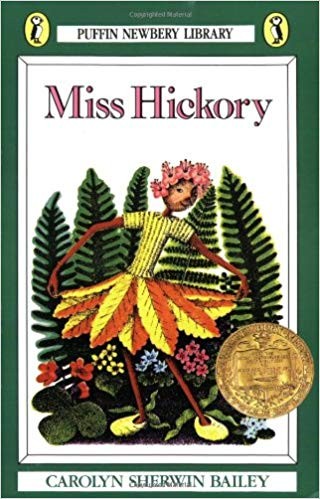September 2018

Miss Hickory
by Carolyn Sherwin Bailey
Most dolls lead a comfortable but unadventurous life. This was true of Miss Hickory until the fateful day that her owner, Ann, moved from her New Hampshire home to attend school in Boston—leaving Miss Hickory behind. For a small doll whose body is an apple-wood twig and whose head is a hickory nut, the prospect of spending a New Hampshire winter alone is frightening indeed. In this classic whimsical fairy tale, what’s a doll to do?
A Note from the First Lady
Dear Read20 Book Club families,
Miss Hickory might be the feistiest doll I’ve ever met! With a hickory nut for a head and an apple-wood twig for a torso, this independent-minded handmade toy must fend for herself when she is left behind by the doll maker and her family who travel south for the winter. Miss Hickory might think that she is fine on her own, but it takes a special few forest friends to prove otherwise.
The autumn woods and all its creatures are larger than life in this timeless 1947 Newbery Medal winner. I hope you enjoy reading about Miss Hickory’s adventures like I did when I was younger. Miss Hickory and her new friends might even learn some lessons that are applicable to your life today. Have a great September enjoying the bounty that the fall season brings!
Keep up the great reading!
Crissy Haslam
First Lady of Tennessee
Fun Family Activities
1. Investigate: There are many animal friends that appear throughout the book, and they each bring a different perspective, help Miss Hickory in unique ways and have adventures of their own. Research forest animal behavior: deer, squirrels, chipmunks, bullfrogs, rodents, etc. What do they eat? Where and how do they nest? How do they stay warm during the chilly winter months? Our state parks are a great place to explore animals and their behavior in person. Find a state park near you and take a walk through the park with an adult. See if you can find and identify any animal habitats, tracks, or even the creatures themselves!
2. Figurative Language: In Miss Hickory, author Carolyn Sherwin Bailey uses many different forms of figurative language to creatively tell the story of Miss Hickory and her forest friends. She employs personification, giving human qualities, characteristics, and behaviors to non-human things like objects, ideas, or, in this case, animals. Do dolls or squirrels usually talk, scold, befriend or lie? Why do you think the author chose these characters to tell the story? Why didn’t she choose to use humans to teach these lessons? Carolyn Sherwin Bailey also uses simile, comparing two things using “like” or “as” to make a point (for example, “My dad is as wise as an owl”). Can you find an example of a simile from Miss Hickory? How does the author compare two different things to paint a picture or get you to think about an idea in a certain way? Explain.
3. Haiku: A haiku is a traditional form of Japanese poetry typically written about something in nature. Haikus are very short poems made up of three lines: the first and last lines are made up of five syllables and the middle line is made up of seven syllables. It does not have to rhyme, and should be simple and descriptive. For example:
Ribbit ribbit croak (5)
The bullfrog spoke as he hopped (7)
Muddy on the shore (5)
Take inspiration from the book and write a few haikus of your own. Practice counting out the syllables and see if you can describe a character, scene, place or thing from Miss Hickory’s story in 5,7,5.
4. Further Reading: Miss Hickory by Carolyn Sherwin Bailey is the winner of the 1947 Newbery Medal. The Newbery Medal is awarded annually by the American Library Association for the most distinguished American children's book published the previous year. If you liked Miss Hickory, you should take a look at the list of Newbery Medal award winners from other years! You can find that list here, on the American Library Association website. Check out your local library to find any of these books for your reading pleasure.